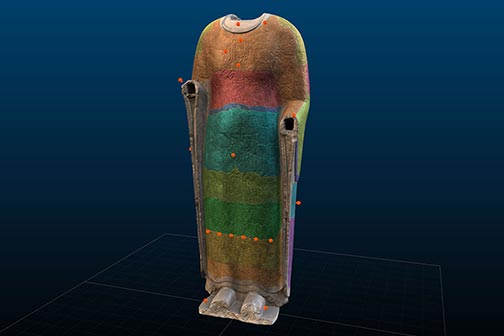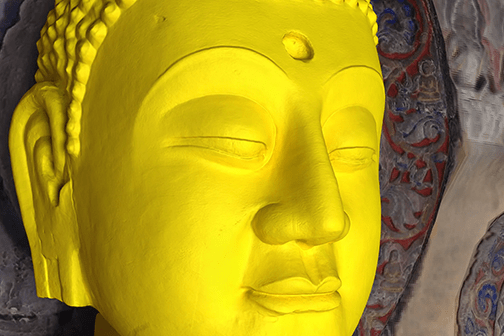January 30, 2016 to July 9, 2017
-
Dates
-
Location
Arthur M. Sackler Gallery
-
Collection Area
Chinese Art
Like all Buddhas (fully enlightened beings), the Cosmic Buddha, a life-size limestone figure of Vairochana, is wrapped in the simple robe of a monk. What makes this sixth-century Chinese object exceptional are the detailed narrative scenes that cover its surface, representing moments in the life of the Historical Buddha as well as the Realms of Existence, a symbolic map of the Buddhist world. With help from the Smithsonian’s Digitization Program Office, the Cosmic Buddha also exists as a 3D model, enabling scholars to study the work as never before and providing worldwide access to this masterpiece of Buddhist sculpture. Body of Devotion is an interactive installation that explores not only the work itself, but also the evolving means and methods of studying sculpture, from rubbings and photographs to the technological possibilities of today.
The Cosmic Buddha

In Chinese Buddhist art, the sixth century was an era of great artistic transformation and theological debate. During that dynamic period, religion enjoyed both imperial patronage and abundant popular support. Promise of Paradise, an exhibition of the permanent collection in the Freer Gallery of Art, brings together finely carved stone figures, architectural reliefs, and gilt bronzes from that pivotal period. Together the works illustrate how beliefs, artistic techniques, and religious expression both rapidly evolved and provided a foundation for later innovations.
One sculpture deserving particular attention is a late sixth-century image of the Buddha. A complex decoration of low-relief narrative scenes covers its surface. To better elucidate the significance of these carvings, Keith Wilson, curator of ancient Chinese art at the National Museum of Asian Art, turned to digital resources for assistance in closely examining this imposing sculpture.
Scholars have identified the headless figure as Vairochana, the Cosmic Buddha (Pilushena in Chinese). The iconography of the narrative scenes that cover its form-fitting robe represents the life of the Historical Buddha as well as the “Realms of Existence,” a symbolic map of the Buddhist world. In Buddhist texts, Vairochana is described as the generative force behind all phenomena in the universe. He is also a central figure in the Chinese schools of Tiantai and Huayan. The narrative scenes are spiritual emanations rising from the Buddha himself and illustrate fundamental Buddhist teachings. These scenes originally would have been painted, as suggested by the slight traces of pigment that remain.
Following the success of the 2011 exhibition Echoes of the Past, Wilson recognized the potential of digital imaging techniques. That earlier exhibition utilized 3D-imaging technology to explore an important group of late sixth-century devotional sites: the Buddhist cave temples of Xiangtangshan in northern China. In the early twentieth century sculptures had been removed from the caves. Technology made it possible to reconstruct one of the caves by layering high-resolution color photographs and 3D laser scans of the missing sculptures onto digitized scans of the interior as it now looks. Visitors could thus experience a Buddhist cave in its original arrangement, an impossible experience today.
To create an interactive, web-based resource about the Cosmic Buddha, Wilson partnered with the Smithsonian Institution’s Digitization Program Office (DPO). That office is charged with creating images of the Smithsonian’s collections through both photography and 3D modeling. As part of a joint initiative between DPO and the Freer and Sackler Galleries, digitization experts Adam Metallo, Vince Rossi, and Jon Blundell scanned the Cosmic Buddha over a two-week period in the fall of 2011.

Those scans were then digitally stitched together to create a 3D model, the basis for an interactive web module. Generously supported by the 2D and 3D software developer Autodesk, the web interface software allows viewers to rotate the sculpture, adjust lighting, and zoom in to see details of the sculpture’s surface. The module features guided tours written by Wilson and geologist Janet Douglas, a former NMAA conservation scientist. For example, Douglas presents overviews of the stone-working technique that was used to carve the sculpture, a scientific profile of the stone itself, and the sculpture’s conservation history. Wilson annotates the sculpture to explain the complex iconography that is derived from religious texts and theological discussions. More tours will be added as research progresses, thus allowing the public to follow developments and new findings.
Through the use of this digital model, Wilson and other researchers can study the sculpture and its exceptional details in a new way. Scholars have long relied on rubbings to read such low-relief carvings, using black ink on white paper to make the patterns and scenes more legible. Today’s 3D modeling provides a far clearer view of the sculpture’s surface. Wilson can now detect previously unreadable details, and he is undertaking a comprehensive survey of the complex scenes depicted over the sculpture’s surface. This newfound ability has led him to conclude that the Freer’s Cosmic Buddha may well have been designed to serve as a teaching sculpture, probably in a monastery, where a narrator provided commentary and instruction on the teachings of Buddhism.

The scans’ clarity makes it easier than ever to map the surface and more clearly identify the borders of scenes and the figures they contain. Spatial depth in the narrative units is created through diagonals, vanishing points, and layered landscapes. By looking at 3D prints, scholars can now study these scenes for their artistic merit in a manner similar to paintings. The prints might help elucidate early Chinese narrative illustration and provide vital insight into the visual culture of sixth-century China.
Thanks to the 3D model, the Cosmic Buddha can now be examined collaboratively in ways as never before, with “copies” of the sculpture being shared with colleagues in China and elsewhere around the world. In October 2016, the Freer and Sackler Galleries plan to hold a conference on the Cosmic Buddha, convening the field around a seminal period of Chinese Buddhist art and providing a forum for considering a single sculpture and the milieu in which it was created.
Creating and studying digital images of the Cosmic Buddha demonstrate how technology can aid art historians, Buddhist scholars, and other researchers and interested people around the world by providing them with greater access to a masterpiece of Buddhist sculpture.
Learn more about the Cosmic Buddha
Angela Howard. Imagery of the Cosmological Buddha. Leiden: Brill, 1986.
Denise Leidy. The Art of Buddhism: An Introduction to Its History and Meaning. Boston: Shambhala, 2008.
Learn More
-

3D Model
The Cosmic Buddha
Image courtesy Smithsonian’s Digitalization Program Office
- Jump To...
Explore All Pieces in this Section
Buddha draped in robes portraying the Realms of Desire
-
Period
Northern Qi dynasty
-
Geography
Anyang, Henan province, China
-
Material
Limestone
-
Accession
F1923.15





